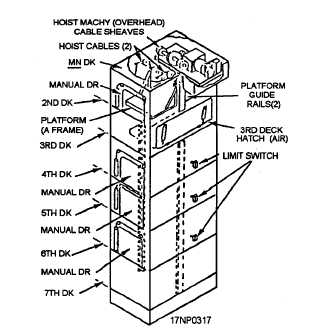operated. In addition, all of the elevators are rated for a
9,000-pound load capacity, and the elevator trunks have
side-loading capabilities at several magazine levels.
Except for minor differences, the elevators aboard
the USS Eisenhower and the USS Carl Vinson are
almost identical to those aboard the USS Nimitz.
The foIlowing text contains a brief description of
the two major classifications (lower-stage and
upper-stage) of weapons elevators. Regardless of the
type of installation a weapons elevator provides a safe
and efficient means for you to handle weapons and
weapons components among the magazines and the
various assembly, staging, and arming areas within the
ship.
LOWER-STAGE WEAPONS ELEVATORS
(5,500 POUNDS).— The 5,500-pound, lower-stage,
weapons elevator (fig. 11-15) services magazines and
ammunition handling areas from the 7th-deck level up
to and including the 2nd-deck level. The components
of the elevator include an electrically powered,
multiple-drum winch, an elevator platform, an enclosed,
watertight, vertical trunk with doors located at the levels
and stations serviced, and a semiautomatic control
system.
Ramps are used to bridge the gaps in the door
opening between the elevator platform and the deck.
These allow you to load or unload the elevator platform
by using forklift trucks or wheeled skids.
Figure 11-15.—Typical 5,000-pound lower-stage, weapons
elevator.
Each lower-stage elevator is equipped with a
broken-rope safety device, a down-speed governor
device, and slack cable-sensing devices. The
broken-rope safety device is mounted on the elevator
platform assembly.
If any one of the platform
suspension ropes break, a roller-wedging mechanism
automatically operates to lock the platform to the guide
rails.
A counterweight-type governor device for limiting
speed of elevator down travel is located in the upper
end of the elevator trunk. The governor is operated by
a wire rope connected to a lever of the broken-rope
safety device on the elevator platform. Then, the rope
is passed over the governor sheave and attached to the
governor spooling drum on the hoisting winch.
Excessive down speed causes the governor limit switch
to shutoff the power to the hoist motor and electric
brake. Loss of electric power causes the brake to
automatically stop the elevator. If the brake fails to stop
the elevator, the governor sheave grips the governor
rope, causing the broken-rope safety device to stop the
elevator.
A slack, cable-sensing, safety device is provided for
each suspension rope and the governor rope. Located
in the area between the winch drums and the overhead
sheaves, these devices function by applying a
spring-loaded follower roller to the wire rope. Rope
slack causes a proximity switch to shutoff electrical
power to the hoisting winch motor and brake, which
stops the elevator.
If the elevator overtravels upward beyond the
maximum up stop position, an overtravel limit switch is
actuated. This stops the elevator by shutting off power
to the hoisting winch motor and brake.
If the elevator overtravels downward beyond the
hold deck loading station level, the platform is stopped
by spring bumpers in the bottom of the elevator trunk.
The slack-cable switches are actuated to cut off power
to the hoisting winch motor and brake.
An operator-attended control panel is located next
to all elevator doors. All operator control panels have a
display of selector switches, pushbuttons, and indicator
lamps suited for the control functions required at the
station served. All control panels have an emergency
stop-run switch from which all operations of the
elevator can be stopped.
The main operator control panel and electrical
power switch are located at the 2d deck-level station.
An elevator can be dispatched to another level from any
operator control panel. The lower-stage elevator control
11-24



